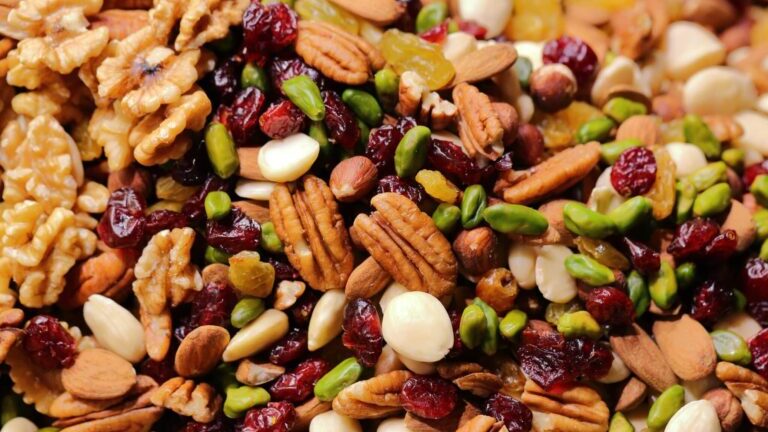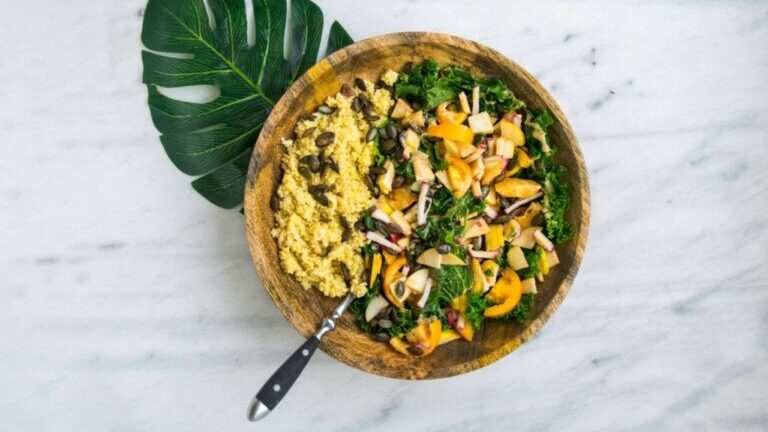

As more individuals become health conscious, specific diets like the gluten free vegan diet are rising in popularity. To fully understand this lifestyle choice, let’s break down its two components: the gluten free diet and the vegan diet.
A gluten free diet involves the complete elimination of gluten, a protein found in grains like wheat, barley, and rye. People who have celiac disease, a serious autoimmune disorder, or those with a gluten sensitivity or intolerance, often follow a gluten free diet to manage their symptoms and improve their overall health.
Foods that commonly contain gluten include bread, pasta, cereals, and baked goods. However, gluten can also be found in less obvious foods and products, such as sauces, dressings, and even certain medications and supplements. For a list of safe, gluten free foods, check out our article on gluten free foods.
A vegan diet, on the other hand, is a plant-based diet that excludes all animal products, including meat, dairy, eggs, and honey. This diet is often chosen for ethical, environmental, or health reasons.
Vegans rely heavily on foods like fruits, vegetables, legumes, grains, seeds, and nuts for their nutrition. It’s important for vegans to plan their meals carefully to ensure they are getting a balanced intake of nutrients, particularly those commonly found in animal products, such as protein, vitamin B12, and iron.
When combined, the gluten free vegan diet represents a lifestyle that excludes all animal products and gluten-containing grains. This means that staples of a vegan diet, such as seitan (a meat substitute made from wheat gluten) and many whole grains, are off the table.
However, this diet doesn’t have to be restrictive. There are many naturally gluten free and vegan foods available, including fruits, vegetables, legumes, and certain grains like quinoa and rice. Gluten free alternatives for common wheat-based foods, such as gluten free bread, gluten free pasta, and gluten free flours are also widely available.
Transitioning to a gluten free vegan diet may seem challenging, but with careful planning and a little creativity, it’s entirely possible to enjoy a wide variety of delicious and nutritious foods. For meal planning ideas and tips, refer to our guide on gluten free vegan meal prep.
Adopting a gluten free vegan diet can offer several health benefits. This dietary regimen, which combines the principles of a vegan lifestyle with a gluten free approach, can improve digestive health, contribute to weight management, and provide a nutrient-rich, balanced diet.
For individuals with celiac disease or gluten intolerance, adopting a gluten free diet can significantly improve digestive health. Gluten, a protein found in wheat, barley, and rye, can cause inflammation in the small intestine and lead to symptoms such as bloating, diarrhea, and abdominal pain. By eliminating gluten from the diet, these symptoms can be alleviated, leading to improved gut health and overall well-being.
A vegan diet, which excludes all animal products, can also contribute to better digestive health. Plant-based foods are typically high in fiber, which supports healthy gut bacteria and aids in digestion. A diet rich in fruits, vegetables, legumes, and whole grains can promote regular bowel movements and prevent constipation.
A gluten free vegan diet can also support weight management efforts. Plant-based diets are often lower in calories and saturated fats, helping to maintain a healthy weight. Additionally, many gluten-free foods are naturally lower in calories, assisting in calorie control.
Maintaining a healthy weight is crucial for heart health. Overweight and obesity are risk factors for cardiovascular diseases. By promoting weight management, a gluten free vegan diet can lower the risk of heart disease. Moreover, a plant-based diet is naturally low in cholesterol and saturated fats, further supporting cardiovascular health.
Despite the restrictions, a well-planned gluten free vegan diet can provide a wide array of essential nutrients. Fruits, vegetables, legumes, nuts, seeds, and gluten-free grains are all packed with vitamins, minerals, antioxidants, and dietary fiber, supporting overall health.
However, it’s important to ensure that the diet is well-balanced and meets all nutritional needs. Certain nutrients, such as vitamin B12, iron, and omega-3 fatty acids, can be more challenging to obtain from a vegan diet. Likewise, individuals on a gluten-free diet should ensure that they are getting enough fiber and whole grains. Careful meal planning and a variety of gluten free vegan foods can ensure a balanced, nutrient-rich diet.
| Nutrient | Food Sources |
|---|---|
| Vitamin B12 | Fortified plant-based milks, nutritional yeast |
| Iron | Legumes, fortified cereals, quinoa, spinach |
| Omega-3 Fatty Acids | Flaxseeds, chia seeds, hemp seeds, walnuts |
Overall, the gluten free vegan diet can provide numerous health benefits when followed correctly. However, it’s important to consult with a healthcare professional or a dietitian to ensure that all nutritional needs are being met.
Embarking on a gluten free vegan journey can seem daunting due to some common concerns. However, with comprehensive knowledge and strategic planning, these challenges can be effectively managed.
One of the main concerns with a gluten free vegan diet is ensuring adequate protein intake. As both animal products and gluten-containing grains are excluded, alternative protein sources need to be identified.
Lentils, chickpeas, quinoa, and tofu are excellent sources of protein. Additionally, a variety of gluten free grains and seeds, such as amaranth, millet, and chia seeds, can supplement protein intake.
For a more concentrated source of protein, consider gluten free protein powders derived from peas, hemp, or brown rice. Read more about gluten free protein powders here.
Another concern pertains to maintaining optimal vitamin and mineral levels, particularly Vitamin B12, iron, and calcium, which are commonly found in animal products.
To address this, incorporate foods fortified with these nutrients, like plant-based milks and breakfast cereals. Nutritional yeast is an excellent source of B12. Iron can be obtained from lentils, chickpeas, and spinach, while calcium is abundant in fortified plant milks, tofu, and certain leafy greens.
Managing dietary restrictions can seem challenging, particularly when dining out or attending social events. However, with the increasing awareness and popularity of gluten free vegan diets, many restaurants now offer suitable options. Our guide to gluten free restaurants can help navigate dining out.
Understanding food labels is crucial to identifying hidden sources of gluten or animal products. Gluten can lurk in unexpected places, including sauces, dressings, and certain processed foods. Our guide to gluten free grocery shopping can facilitate smarter choices.
Overcoming dietary restrictions also involves creative cooking and baking. With a plethora of gluten free vegan recipes available, it’s possible to recreate favorite meals in a compliant manner. Visit our gluten free recipes section for inspiration.
While the gluten free vegan diet comes with its set of challenges, they are far from insurmountable. With careful planning and informed choices, it’s possible to lead a healthy and balanced gluten free vegan lifestyle.
Making the decision to switch to a gluten free vegan diet can be a significant lifestyle change. However, with careful planning and knowledge, the transition can be smooth and rewarding.
Transitioning to a gluten free vegan diet doesn’t have to be an overnight process. Gradual changes can make the shift easier to manage and sustain in the long run. Start by incorporating more gluten free foods and plant-based meals into your diet. Gradually, you can replace animal products and gluten-containing foods with vegan and gluten free alternatives.
Meal planning is an effective strategy for maintaining a balanced and nutritious gluten free vegan diet. Make a list of all the foods you can eat, such as fruits, vegetables, legumes, nuts, seeds, and gluten free grains. With this list, you can create a diverse and enjoyable meal plan. For inspiration, check out our gluten free vegan recipes.
Understanding food labels is crucial when following a gluten free vegan diet. Many processed foods can contain hidden sources of gluten or animal products. When shopping, look for labels that clearly state ‘gluten free’ and ‘vegan’.
However, not all gluten sources are clearly labeled. Ingredients such as malt (made from barley), certain food starches, and some natural flavors may contain gluten. Become familiar with these hidden sources to avoid accidental consumption.
Also, remember that ‘wheat free’ does not necessarily mean ‘gluten free’. Other grains such as barley and rye also contain gluten. For a comprehensive guide on decoding food labels, check out our article on gluten free grocery shopping.
Transitioning to a gluten free vegan diet can be a journey of discovering new foods, recipes, and healthier eating habits. While it may seem challenging initially, the health benefits of this lifestyle can be well worth the effort. As with any dietary change, it’s always a good idea to consult with a healthcare professional or dietitian to ensure your nutritional needs are being met.
Adopting a gluten free vegan diet doesn’t mean giving up delicious and nutritious meals. In fact, there are countless dishes to explore, from breakfast and lunch to dinner and dessert. Here are some gluten free vegan recipe ideas that are easy to prepare and packed with flavor.
Start your day with a healthy and energizing breakfast. Here are a few ideas for gluten free vegan breakfast dishes:
Quinoa Breakfast Bowl: Cook quinoa in almond milk until it becomes creamy. Top it with a variety of fruits, nuts, and seeds for a wholesome start to your day.
Chickpea Pancakes: Blend chickpea flour with water, salt, and spices of your choice. Cook the batter like a regular pancake and serve with a side of fresh fruits or a dollop of vegan yogurt.
Smoothie Bowls: Blend your favorite fruits with a plant-based milk and top with gluten-free granola, nuts, seeds, or coconut flakes.
For more breakfast ideas, be sure to check out our gluten free breakfast recipes.
For lunch and dinner, consider the following gluten free vegan ideas:
Buddha Bowls: Combine a base of gluten-free grains like quinoa or brown rice with a variety of vegetables, a protein source like chickpeas or tofu, and a tasty dressing.
Stuffed Bell Peppers: Stuff bell peppers with a mixture of quinoa, black beans, corn, and spices, then bake until tender.
Lentil Soup: Simmer lentils with vegetables, herbs, and spices for a hearty and nutritious soup.
Explore more ideas in our gluten free lunch and gluten free dinner sections.
For those moments when you need a snack or a sweet treat, here are a few gluten free vegan options:
Roasted Chickpeas: Roast chickpeas in the oven with your favorite spices for a crunchy and protein-packed snack.
Fruit and Nut Bars: Blend dates, nuts, and dried fruits of your choice, press into a pan, and chill until firm.
Avocado Chocolate Pudding: Blend ripe avocados with cocoa powder, a sweetener of choice, and a splash of plant-based milk for a creamy and decadent dessert.
For more delightful treats, don’t forget to browse our gluten free snacks and gluten free desserts sections.
Trying out these recipes can be a fun and creative way to explore the world of gluten free vegan cuisine. Remember, the key to a balanced diet is variety, so don’t hesitate to experiment with different ingredients and flavors. Happy cooking!
